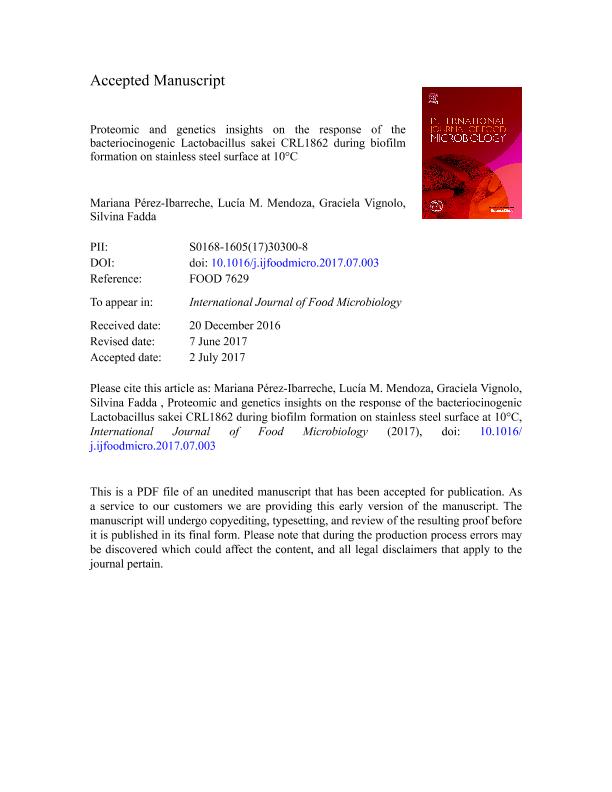Artículo
Proteomic and genetics insights on the response of the bacteriocinogenic Lactobacillus sakei CRL1862 during biofilm formation on stainless steel surface at 10 °C
Pérez Ibarreche, Mariana ; Mendoza, Lucia Margarita
; Mendoza, Lucia Margarita ; Vignolo, Graciela Margarita
; Vignolo, Graciela Margarita ; Fadda, Silvina G.
; Fadda, Silvina G.
 ; Mendoza, Lucia Margarita
; Mendoza, Lucia Margarita ; Vignolo, Graciela Margarita
; Vignolo, Graciela Margarita ; Fadda, Silvina G.
; Fadda, Silvina G.
Fecha de publicación:
10/2017
Editorial:
Elsevier Science
Revista:
International Journal of Food Microbiology
ISSN:
0168-1605
Idioma:
Inglés
Tipo de recurso:
Artículo publicado
Clasificación temática:
Resumen
Some lactic acid bacteria have the ability to form biofilms on food-industry surfaces and this property could be used to control food pathogens colonization. Lactobacillus sakei CR1862 was selected considering its bacteriocinogenic nature and ability to adhere to abiotic surfaces at low temperatures. In this study, the proteome of L. sakei CRL1862 grown either under biofilm on stainless steel surface and planktonic modes of growth at 10 °C, was investigated. Using two-dimensional gel electrophoresis, 29 out of 43 statistically significant spots were identified by matrix-assisted laser desorption/ionization time-of-flight mass spectrometry. Ten proteins resulted up-regulated whereas 16 were down-regulated during biofilm formation. Differentially expressed proteins were found to belong to carbohydrate, nucleotide, aminoacid and lipid metabolisms as well as translation, peptide hydrolysis, cell envelope/cell wall biosynthesis, adaption to atypical conditions and protein secretion. Some proteins related to carbohydrate and nucleotide metabolisms, translation and peptide degradation were overexpressed whereas those associated to stress conditions were synthesized in lower amounts. It seems that conditions for biofilm development would not imply a stressful environment for L. sakei CRL1862 cells, directing its growth strategy towards glycolytic flux regulation and reinforcing protein synthesis. In addition, L. sakei CRL1862 showed to harbor nine out of ten assayed genes involved in biofilm formation and protein anchoring. By applying qRT-PCR analysis, four of these genes showed to be up regulated, srtA2 being the most remarkable. The results of this study contribute to the knowledge of the physiology of L. sakei CRL1862 growing in biofilm on a characteristic food contact surface. The use of this strain as green biocide preventing L. monocytogenes post-processing contamination on industrial surfaces may be considered.
Palabras clave:
Adhesion Genes
,
Biofilm
,
L. Sakei
,
Proteomics
,
Stainless Steel Surface
Archivos asociados
Licencia
Identificadores
Colecciones
Articulos(CERELA)
Articulos de CENTRO DE REFERENCIA PARA LACTOBACILOS (I)
Articulos de CENTRO DE REFERENCIA PARA LACTOBACILOS (I)
Articulos(INSIBIO)
Articulos de INST.SUP.DE INVEST.BIOLOGICAS
Articulos de INST.SUP.DE INVEST.BIOLOGICAS
Citación
Pérez Ibarreche, Mariana; Mendoza, Lucia Margarita; Vignolo, Graciela Margarita; Fadda, Silvina G.; Proteomic and genetics insights on the response of the bacteriocinogenic Lactobacillus sakei CRL1862 during biofilm formation on stainless steel surface at 10 °C; Elsevier Science; International Journal of Food Microbiology; 258; 10-2017; 18-27
Compartir
Altmétricas



